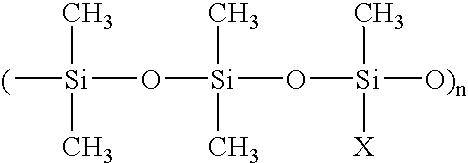Defoamer emulsion compositions for pulp mill applications
a technology of emulsion composition and pulp mill, which is applied in the field of defoamer emulsion composition for pulp mill applications, can solve the problems of high temperature and high ph of black liquor in the mill, the most challenging pulp and paper mill application involving black liquor, and the addition of chemical additives to the surfactant load, etc., and achieves the effects of reducing the use of silicone oil, reducing the cost, and favorable environmental profiles
- Summary
- Abstract
- Description
- Claims
- Application Information
AI Technical Summary
Benefits of technology
Problems solved by technology
Method used
Image
Examples
example 1
Use of Lecithin as Stabilizing Agent
[0054] Several products were evaluated to increase the miscibility of soy methyl ester and silicone oil (Table 1). The evaluation procedure entails the addition of a red dye (i.e. Oil red 0 biological stain from Sigma-Aldrich, St. Louis, Mo.) to highlight the triglyceride oil in a triglyceride oil / silicone oil mixture. Equal amounts of soy methyl ester and silicone oil (i.e. 25 mL of each oil) are mixed in a 100 mL glass container. A 1% concentration by weight of a stabilizing agent based on the weight of the oil blend (e.g., lecithin) was added and well mixed. The mixtures were evaluated for miscibility after one day by measuring with a ruler the separation length of the top layer. Miscibility is reported as a percentage comparison of product vs. no product.
[0055] As can be seen from Table 1, Lecigran 5750, a de-oiled lecithin product from Riceland, was found to be successful in increasing the miscibility of silicone oil and soy methyl ester. ...
example 2
Surface Tension for the Blends of Triglyceride Oil and Silicone oil
[0056] Surface tension of various vegetable oil mixtures was measured with a Kruss Processor Tensiometer K12 (Kruss USA—NC). This equipment measures surface tension with the Wilhelny plate method. The technique is well known in the art and it consists of a thin platinum plate suspended form the arm of a balance that dips into a liquid. The container holding the liquid is gradually lowered and the force on the balance is recorded at the point of detachment. The surface tension is calculated from the force of detachment, the weight and perimeter of the plate.
[0057] It was found that a 96%:4% mixture of soybean oil: castor oil generated a minimum in surface tension (FIG. 1). A number of samples that varied in the amount of soybean oil and castor oil were made (Table 2). The foam cell results are shown in Table 3. The defoamer efficacy evaluation indicated that the optimal defoamer performance was obtained at a low cas...
example 3
Defoamers with Triglyceride Oil and Silicone Oil
[0059] Defoamers were evaluated for their defoaming efficacy on a foam cell, consisting of a graduated laboratory-type Nalgene® cylinder, the bottom of which was modified with a draw-off hole to allow drainage and recirculation. For liquid circulation, the black liquor was pumped from the bottom draw-off through a mechanical pump (at a constant speed of 1800 rpm) and pumped the liquor back to the top of the cylinder. Column temperature was controlled using insulating and heating tape. Equal volumes of black liquor were added to the column for each test, and the temperature was kept constant throughout the test (e.g., 80° C.). Foam was generated by introducing air via an unsealed ¼ inch pipe nipple into the recirculation loop. The volume of the foam was measured every 15 seconds for 5 minutes. The defoamer was added to the black liquor just before foam generation. At least one control run was made every day where no defoamer is added. ...
PUM
| Property | Measurement | Unit |
|---|---|---|
| Temperature | aaaaa | aaaaa |
| Fraction | aaaaa | aaaaa |
| Percent by mass | aaaaa | aaaaa |
Abstract
Description
Claims
Application Information
 Login to View More
Login to View More - R&D
- Intellectual Property
- Life Sciences
- Materials
- Tech Scout
- Unparalleled Data Quality
- Higher Quality Content
- 60% Fewer Hallucinations
Browse by: Latest US Patents, China's latest patents, Technical Efficacy Thesaurus, Application Domain, Technology Topic, Popular Technical Reports.
© 2025 PatSnap. All rights reserved.Legal|Privacy policy|Modern Slavery Act Transparency Statement|Sitemap|About US| Contact US: help@patsnap.com



